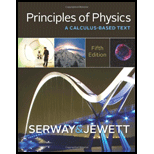
Concept explainers
(a)
The temperature required for the carbon cycle.
(a)
Answer to Problem 41P
The temperature required for the carbon cycle is
Explanation of Solution
Write the expression for the kinetic energy to overcome the columbic repulsion barrier in the proton-proton cycle reaction
Here,
Write the expression for the columbic barrier to Bethe’s fifth and eight reaction.
Here,
Write the expression for the temperature required for the carbon cycle reaction using equation (I) and (II).
Here,
Conclusion:
Substitute
Therefore, the temperature required for the carbon cycle is
(b)
The energy released in each reaction in the carbon cycle and the overall energy released.
(b)
Answer to Problem 41P
The energy released
Explanation of Solution
Let the general reaction in the carbon cycle is as follows.
Here,
Write the expression for the energy released in the reaction given in equation (I).
Here,
Write the expression for the total energy released in the carbon-cycle reaction.
Here,
Conclusion:
Substitute
Substitute
Substitute
Substitute
Substitute
Substitute
Substitute
Substitute
Substitute
Therefore, the energy released
(c)
Whether the energy carried off by the neutrinos is deposited in the star.
(c)
Answer to Problem 41P
Not all the energy appeared as the internal energy in the star. When the neutrino is created, it is likely to fly apart without interacting with any other particles.
Explanation of Solution
The amount of energy released in the reaction is not appeared as the internal energy in the star. When a neutrino is created, it is more likely to fly directly out of the star without any interaction with other particles.
Conclusion:
Therefore, all the energy is not appeared as the internal energy in the star. When the neutrino is created, it is likely to fly apart without interacting with any other particles.
Want to see more full solutions like this?
Chapter 30 Solutions
Bundle: Principles of Physics: A Calculus-Based Text, 5th + WebAssign Printed Access Card for Serway/Jewett's Principles of Physics: A Calculus-Based Text, 5th Edition, Multi-Term
 Principles of Physics: A Calculus-Based TextPhysicsISBN:9781133104261Author:Raymond A. Serway, John W. JewettPublisher:Cengage Learning
Principles of Physics: A Calculus-Based TextPhysicsISBN:9781133104261Author:Raymond A. Serway, John W. JewettPublisher:Cengage Learning Modern PhysicsPhysicsISBN:9781111794378Author:Raymond A. Serway, Clement J. Moses, Curt A. MoyerPublisher:Cengage Learning
Modern PhysicsPhysicsISBN:9781111794378Author:Raymond A. Serway, Clement J. Moses, Curt A. MoyerPublisher:Cengage Learning Physics for Scientists and Engineers with Modern ...PhysicsISBN:9781337553292Author:Raymond A. Serway, John W. JewettPublisher:Cengage Learning
Physics for Scientists and Engineers with Modern ...PhysicsISBN:9781337553292Author:Raymond A. Serway, John W. JewettPublisher:Cengage Learning Glencoe Physics: Principles and Problems, Student...PhysicsISBN:9780078807213Author:Paul W. ZitzewitzPublisher:Glencoe/McGraw-Hill
Glencoe Physics: Principles and Problems, Student...PhysicsISBN:9780078807213Author:Paul W. ZitzewitzPublisher:Glencoe/McGraw-Hill University Physics Volume 3PhysicsISBN:9781938168185Author:William Moebs, Jeff SannyPublisher:OpenStax
University Physics Volume 3PhysicsISBN:9781938168185Author:William Moebs, Jeff SannyPublisher:OpenStax College PhysicsPhysicsISBN:9781285737027Author:Raymond A. Serway, Chris VuillePublisher:Cengage Learning
College PhysicsPhysicsISBN:9781285737027Author:Raymond A. Serway, Chris VuillePublisher:Cengage Learning





